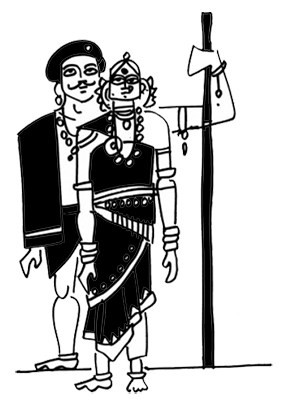Fashion of the gods : Dr Devdutt Pattanaik
 Published in Devlok, Sunday Midday, July 22, 2012
Published in Devlok, Sunday Midday, July 22, 2012
I was browsing through famous fashion designer, Wendell Rodrigues’ wonderful book on Goan fashion: Moda Goa. In tracing earliest fashion that may have existed in the Goan region, we enter the realm of mythology and discover images of gods still worshipped who display what would have been the clothes of our ancestors. I say our ancestors, and not just ancient Goan clothing, because I realized the same clothing would have been seen across India.
Goa, like much of the Western coast of India, is associated with Parashuram, the Ram who held an axe, and belonged to the clan of Bhrigu sages. It is postulated that he is perhaps a mythic embodiment of sages who brought the Vedic way of thinking to a land that was otherwise inhabited by hill tribes (there are cave drawings and markings in Goa that can be traced to the Stone Ages).
What did Parashuram and the sages wear? It was probably ‘valkal’ – fabric made by beating the leaves and the bark of the banyan or pipal fig trees. They may have also used animal hide. And bedecked themselves with flowers (Lakshmi’s lotus), and leaves (Hanuman’s Arka) and seeds (Shiva’s Rudraksha).
What stands out in the later period is the use of unstitched cloth draped in various ways around the body, and extensive use of jewelry. Both these fashions indicate rise of settled communities because spinning, weaving, dying, mining, smelting and smithy demands expertise.
Some of the images – the most spectacular being that of Bhairava, known locally as Betaal – reveal guardian gods and fertility goddesses who wear nothing but huge chunky jewelry. Was this reality or artistic fantasy ? We will never know. But many tribes around the world wear jewelry and expose parts of the body that modern society considers private.
A common dress worn by the tribes even today, and could have been worn in ancient times, is a simple woolen blanket thrown over the shoulders and a loin cloth around the genitals, or a sarong wrapped around the waist. Were these the clothes that the vanars or ‘monkeys’ of Kishkinda wore when they encountered Ram and Lakshman?
With the rise of what is called the classical, or pre-Islamic period, comes the use of men and women draping cloth mostly cotton, sometimes Indian silk and occasionally shimmering expensive Chinese silk with gold threads interwoven – one cloth for the poor to cover the lower parts, two cloths for the slightly rich to cover the upper and lower bodies, and three clothes for the very rich to cover even the head with a veil or turban. Gradually, women in Goa, as in many parts of the Deccan, wore the eight or nine yard sari, the upper and lower garment fused into one, wrapped creatively, the lower part like a dhoti and the upper part like a shawl draped across the breasts.
It is interesting to see how the dress of the gods changes with time. The fashion of the gods influenced the community and the community influenced the gods. Typical of Goa and Karnataka, the Shiva-linga is covered with huge brass and silver masks. And the face looks like a Maratha warrior complete with moustache and turban. And the goddesses have a classical half-moon-shaped nose-ring, which is common in Maharashtra too.
Interesting too is the importance to cosmetics, especially pastes and unguents to wash the body and keep away body odor. Hence the practice of giving daily baths with oil and water and unguents to deities, a reminder of what the devotees are also supposed to do.
One does not realize how much knowledge is locked in the temples of India. We just have to look and I am glad Wendell did.









